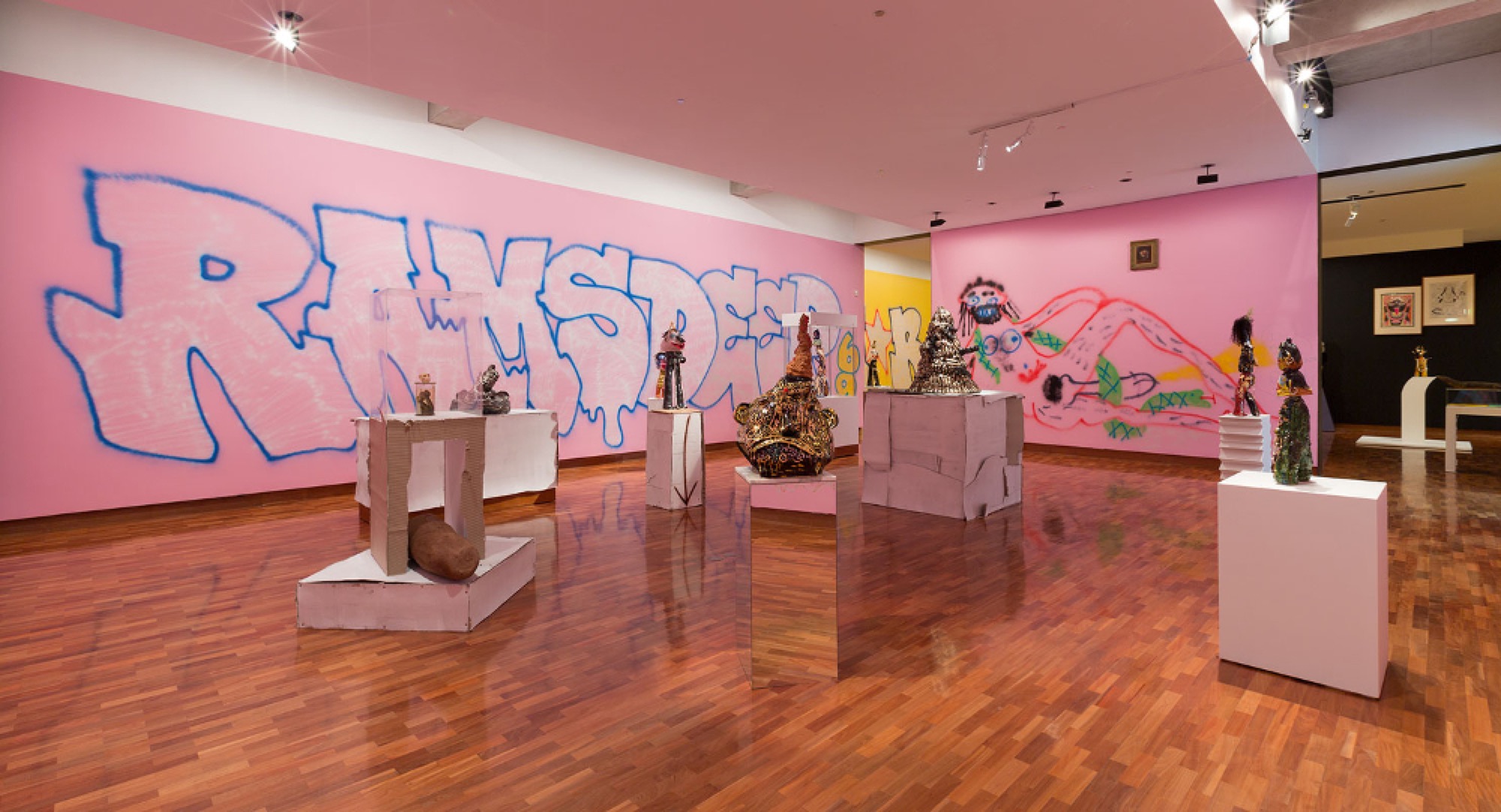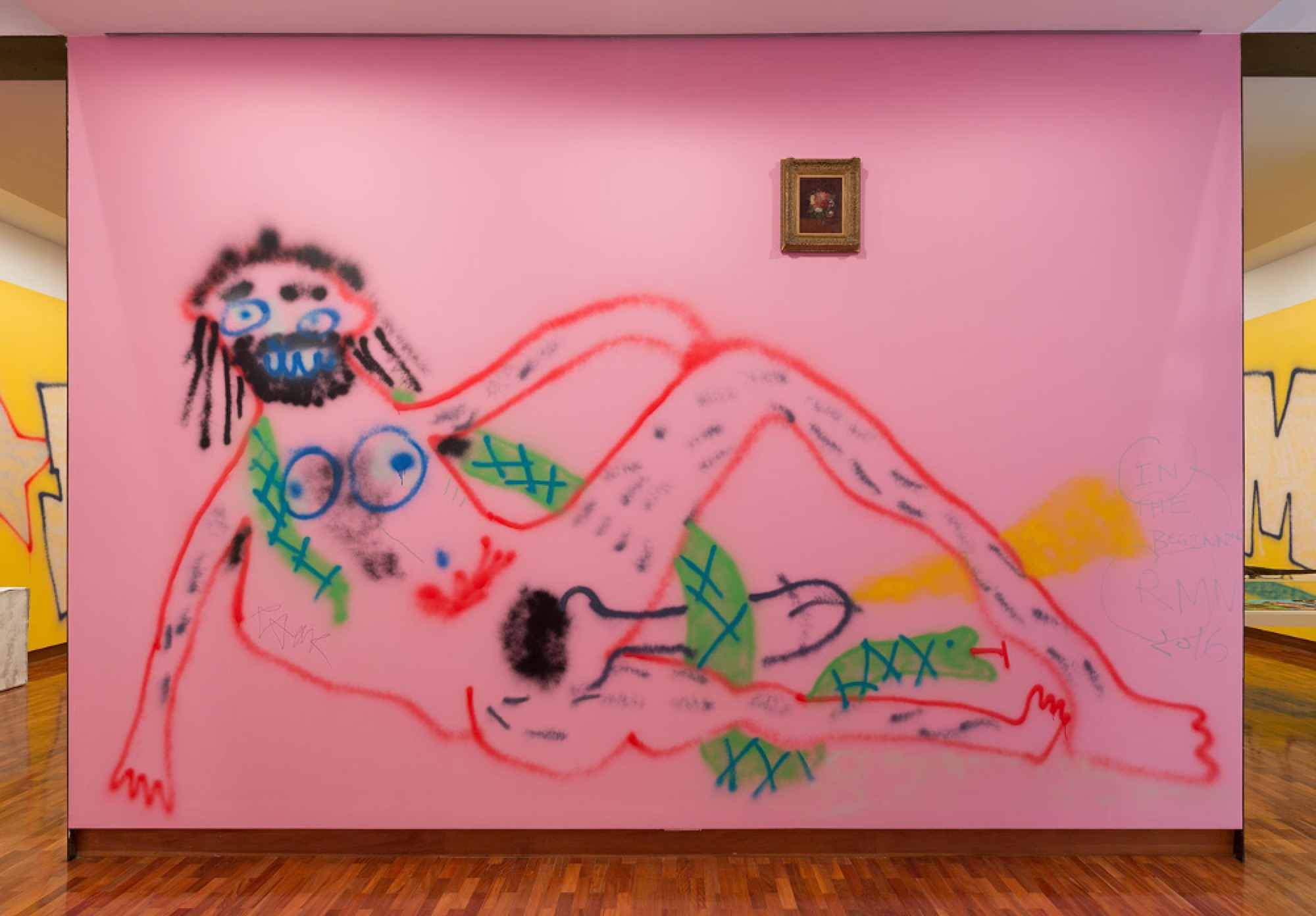Ramesh Nithiyendran: In the beginning
Beth Kearney
Ramesh Mario Nithiyendran’s solo exhibition In the Beginning is arresting. Covertly located on the top floor of the Ian Potter Museum of Art, the Sri Lankan–born, Sydney-based artist introduces confronting imagery and a vibrant palette into the University of Melbourne gallery. Despite Nithiyendran’s potentially off-putting approach, the exhibition engages its audience through religious iconography, contemporary identity politics and its play with art-historical discourse.
Curated by Jacqueline Doughty, In the Beginning demonstrates that Nithiyendran already has ambition and significance as an emerging artist. He has exhibited widely in recent years and has been acquired by several major public collections in Australia. Here, he exhibits nineteen painted ceramics, un-fired clay and bronze sculptures, four self-portraits on paper, a colourful mural of bold letter-type and abstract sketches using spray paint, chalk, enamel and marker pen. Eleven artefacts and taxidermy specimens borrowed from the University of Melbourne Collection add an element of artistic-curatorial engagement with the museum, where Nithiyendran flouts the institutional remit for exhibiting new work alongside historical artefacts.

The exhibition pairs Nithiyendran’s vibrant use of colour with a spiritual and symbolic reflection on Hindu and Christian mythology and iconography. Despite his avowed atheism, Nithiyendran repeatedly references religious creation myths. And yet the artist is not a faithful storyteller because he irreverently rearticulates and reinterprets religious tales. A good example is the anatomically playful depiction of nearly all his figures. In these, Nithiyendran uses chalk or spray paint to endow figures with both breasts and a penis, or to exaggerate the size of their anatomy. Some murals depict what could be either Adam or Eve, Shiva or Parvati. In this way, Nithiyendran reinterprets religious mythologies through a portrayal of gender as either ambiguous or unimportant.
There is also an iconographic overlap in Nithiyendran’s repetition of the serpent motif, which could be a reference to the Abrahamic tale of the Garden of Eden or to Hindu mythologies in which Shiva often has a snake resting around his neck and body. As a phallic symbol, the serpent is a recurring theme, with the ceramic figures often exhibiting exaggerated male anatomy.
Nithiyendran also hyperbolically deploys Modernism’s “primitivist” aesthetic to question colonial representations of indigenous cultures—the exhibition is replete with sculptural and painterly recreations of mask-like faces, real human hair, false teeth and oversized urinating and ejaculating penises. These elements are in keeping with Nithiyendran’s playful and sometimes flippant reinterpretation and aesthetic imitation of religious and modern mythologies.
It is through this play on religious mythologies, gender representation and a “primitivist” aesthetic that Nithiyendran prioritises the comedic effect of his own irreverence. For example, the pervasiveness of the penis, as Jacqueline Doughty points out in her catalogue essay, mirrors the phallocentric condition that continues to pervade contemporary life. As Doughty explains, the irony of the exhibition lies in the fact that Nithiyendran seeks to show how masculinity is universal, and yet the literal exhibition of the penis still manages to shock.
According to Nithiyendran, the relative normality of female nudity in today’s media and art history more generally (he has spoken of René Magritte’s 1945 painting Le Viol) demonstrates the ubiquitous phallocentrism and male voyeurism embedded in historical and contemporary systems of representation. Humour, and the act of reinterpreting history, is Nithiyendran’s vehicle into a space where he can contest and rearticulate these institutionalised, socialised and historicised norms. This reflection on a natural curiosity with our reproductive beginnings, as well as Nithiyendran’s fascination with religious and art historical understandings of gender and race, allow us to consider his own “atheist” spirituality and hence his “creation” beliefs. In the Beginning can therefore also be read as a reflection on the artistic notion of creation, with the artist considering the malleability of clay as both a medium and metaphor of the (re)creation of identity.
The exhibition’s non-conclusive, temporal and spatial reflection on contemporary identity politics points to the intersections of religion, ethnicity, nationality, gender and sexuality. The ambiguity of Nithiyendran’s figures reject the historical exclusion and compromised representation of certain groups in society; and the generally androgynous nudes and self-portraits reflect the greater regard given to gender fluidity today.
Nithiyendran also pairs his reflection on identity politics with strong references to contemporaneity. He does this by implying the digital status and mutability of “netizens”, including his Instagram handle (rams_deep69), referencing internet memes, and using spray paint and chalk to tag “@mesh” or “ramz” on the gallery walls. Oscillating between contemporary debates around notions of identity and their embeddedness in culture and history, Nithiyendran interrogates the institutionalisation of art history and the museological display of art through the work itself.
His borrowings from the University collection—a concrete statue of a Hindu god; two large Indian folk paintings of the Hindu goddess Kali; a taxidermal swan and Asian Water Minor; a fluid-filled tiger snake in a glass jar; artefacts from Cyprus and Greece; and a still life by a British artist from 1892—suggest an ambiguous mix of objects displayed almost comically, artificially cultivating an instant sense of exoticism. But a graffiti-like rendition of Édouard Manet’s Olympia, with both breasts and a penis, sprayed directly on to the eastern wall of the west gallery is Nithiyendran’s boldest reinterpretation of established art-historical discourse and museological display. An 1892 still life oil painting by the British artist Philip Wilson Steer hovers well above Nithiyendran’s version of the reclining Olympia, and both this work and its label are hung a few inches from the gallery ceiling. This positioning, which imitates a Salon-style hang, is another example of Nithiyendran’s irreverent approach to exhibition display. Labels are virtually impossible to read, traditional ceramic-making practices are flouted, plinths no longer use their neutrality to reify the artwork and vitrines no longer protect the works they are meant to house.

While cheeky irreverence toward the functions of the art institution is not entirely novel (think of David Walsh’s playful display of work at the Museum of Old and New Art in Hobart), the premise of this exhibition is arguably the subversion of several historical and sociological norms. Yet, does an elaborate colour scheme, bold and sometimes iconoclastic content and unabashed eroticism and exoticism truly constitute exceptional ingeniousness? In the Beginning could be read either way: as a clever pairing of historical and contemporary observations, or just one more florid bedazzlement of aesthetic and symbolic features.
Despite being a university-based art museum that manages some 14,000 works in its collection, the Potter aims to welcome the general public in equal measure. It may be surprising, then, that staff at the Potter report its visitors having appeared neither offended nor unwilling to engage in the artist’s impertinence and explicit content. Ultimately, most visitors appear intrigued by the dynamism of the exhibition’s ambitious display, and interested enough to explore and engage with Nithiyendran’s sociocultural references, formal experimentation and consciously lurid use of colour. One therefore wonders to what extent these subversions of the museum are expected to shock its spectators, and to what extent they are merely designed to impress them.
Beth Kearney studies Art History as well as French Language and Literature. She is undertaking a research Masters in Montréal from September 2017.
Title image: Ramesh Mario Nithiyendran, In the Beginning, 2016, Installation view, Ian Potter Museum of Art. Photo: Christian Capurro)


